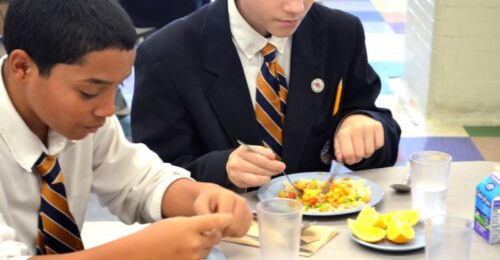Teaching table manners to kids is super important but often overlooked. We pay too much attention to our own table manners, but more often than not, kids are the ones cheekily misbehaving and escaping the restrictions of etiquette.
Enforcing table manners for kids is not just about avoiding awkward moments, but also about nurturing respect, empathy, and consideration for others.
As parents, we have a huge role in shaping their behavior at the dining table. Here, we’ll dive into why table manners matter and share fun tips to make meals a delightful experience for everyone!
Basic Table Manners
A family dinner is not just about satisfying hunger; it’s a cherished opportunity to connect and bond with loved ones.
Teaching kids the significance of washing hands before meals is crucial for maintaining hygiene and health. This simple act instills a sense of responsibility and respect for personal and others’ well-being. It also enhances common courtesy as children learn to wait for others to be seated and refrain from beginning their meals hastily.
Impulse control around mealtime is another vital aspect to address.
Children’s excitement and anticipation around mealtime can sometimes lead to uncontrolled behavior, making it essential to teach them patience and self-discipline. Encouraging them to engage in calm conversation while waiting for the food to be served reinforces the idea of savoring the dining experience as a whole.
Table Etiquette for Kids 101
Table etiquette forms the backbone of social interactions during mealtime, and teaching children the art of dining gracefully is an invaluable life skill. Let’s explore some essential aspects to help instill good habits in kids:
Eating Etiquette
- Chewing with Mouth Closed: Encourage children to chew their food with their mouths closed, fostering a pleasant dining experience for everyone.
- Avoid Talking with Food in the Mouth: Teach kids to finish chewing and swallowing before engaging in conversation, promoting respectful communication at the meal table. Not a problem at a Hawaiian Luau.
- Tackling Picky Eaters: Patience and creativity can go a long way in helping picky eaters. Introduce new foods gradually, involve them in meal preparation, and make dining an enjoyable adventure. If you’ve never been to a luau in Oahu then you may want to check this out because there is a wide spectrum of food.
- Staying Seated During Meals: Emphasize the importance of remaining seated throughout the meal, ensuring a calm and organized dining atmosphere.
By focusing on these mealtime essentials, parents can mold children’s table manners effectively and nurture a positive attitude towards food and dining.
Check our guide on Dinner Cruises in Oahu to learn more about reserving your special seat at a table cruise. Dinner cruises in Maui also available.
Using Cutlery
Teaching children the correct use of cutlery is an essential aspect of proper table etiquette for kids.
Encourage them to hold utensils properly, using the appropriate knife and fork techniques for various types of food. By mastering these skills, kids can become confident and efficient in their dining habits.
Making sure your kid becomes a neat eater is equally crucial. Teach kids to cut food with care and avoid making unnecessary messes.
Gentle reminders to use napkins to wipe their mouths or hands before continuing their meal can help establish cleanliness and tidiness during regular meals.
By consistently reinforcing these practices, parents can cultivate proper table etiquette and create a positive dining environment that encourages their children to become well-mannered and graceful eaters.
Drinking Etiquette
When it comes to drinking etiquette for kids, instilling good habits from a young age can make a difference in their dining experiences.
Teach children to hold their glasses or cups properly, avoiding spills. Encourage them to take small, polite sips instead of gulping down beverages hastily.
Remind them to refrain from making loud slurping noises. These simple tips can foster a sense of grace and courtesy.
Being Courteous to Others
Teaching kids the value of being courteous at the dining table is essential for fostering positive social interactions. Here is a comprehensive list of table manners that parents can impart to their children:
-
- Say “Please” and “Thank You”: Encourage kids to use polite words when requesting food or passing dishes.
- Ask to Be Excused: Teach them to seek permission before leaving the table during a meal.
- Offer to Help: Instill the habit of offering assistance with setting the table or clearing dishes.
- Wait for Others: Remind kids to wait until everyone is served before starting to eat.
- Practice Active Listening: Encourage attentive listening when others are speaking during the meal.
- Use Inside Voices: Teach them to speak at an appropriate volume, avoiding shouting or yelling.
- Avoid Interruptions: Teach kids not to interrupt others’ conversations during meals.
- Respect Personal Space: Encourage giving space to others while eating to avoid bumping elbows or crowding.
- Compliment the Cook: Instill the practice of showing appreciation for the meal and its preparer.
- Check out our Maui Luau Tours for those of you who like things a little less formal
Rewards and Encouragement
Recognizing and reinforcing positive behavior at the table through rewards and encouragement can work wonders in fostering good table manners in kids.
Praising them when they remember to use their utensils correctly or chew with their mouths closed reinforces the value of their efforts.
Offering small incentives, such as a sticker chart or special treat, can make mealtime a fun and motivating experience. On top of that, verbal encouragement and applause for their progress instill confidence and a sense of accomplishment.
Leading by Example
As parents, we hold a powerful influence over our children’s behavior and attitudes. One of the most effective ways to teach good table manners is by leading through example. Some dinner cruises even offer tips on things like this before going to the formal dinner.
When kids witness adults exhibiting proper dining etiquette—sitting attentively, using utensils correctly, and engaging in polite conversation—they are more likely to emulate these behaviors.
Demonstrating patience, respect, and consideration during meals reinforces the importance of these values in their young minds.
Beyond the dining table, showcasing gratitude for meals and showing appreciation for the efforts of the cook also sets a positive tone. By consistently modeling good table manners, we pave the way for our children to develop a strong foundation of social grace that will serve them well throughout their lives.
Conclusion
Teaching good table manners is crucial in raising well-behaved and polite kids. It’s not just about using utensils and being well-behaved; it’s about showing respect and consideration for others.
By encouraging kindness, patience, and gratitude during meals, we give them valuable life skills. Leading by example helps them understand proper dining etiquette. Additionally, gentle reminders and positive reinforcement shape their behavior with love.
With good table manners, kids can confidently handle social situations and enjoy mealtime with family and friends, building strong bonds that last a lifetime.
